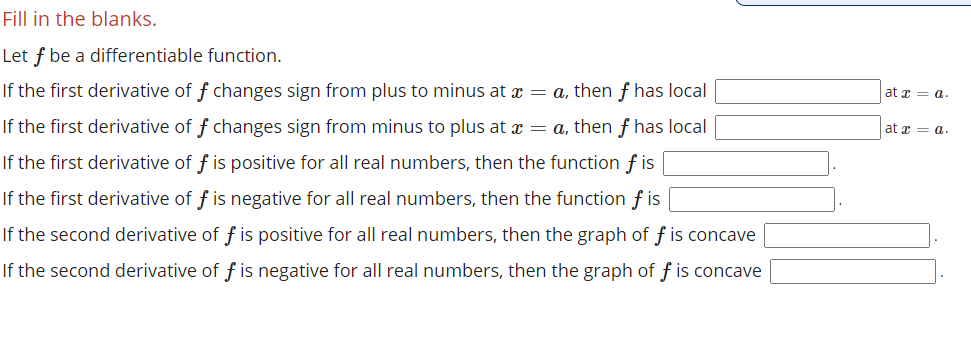Il in the blanks. et f be a differentiable function. the first derivative of f changes sign from plus to minus at x = a, then f has local at z = a. the first derivative of f changes sign from minus to plus at x = a, then f has local at z = a. the first derivative of f is positive for all real numbers, then the function f is the first derivative of f is negative for all real numbers, then the function f is the second derivative of f is positive for all real numbers, then the graph of f is concave the second derivative of f is negative for all real numbers, then the graph of f is concave
Il in the blanks. et f be a differentiable function. the first derivative of f changes sign from plus to minus at x = a, then f has local at z = a. the first derivative of f changes sign from minus to plus at x = a, then f has local at z = a. the first derivative of f is positive for all real numbers, then the function f is the first derivative of f is negative for all real numbers, then the function f is the second derivative of f is positive for all real numbers, then the graph of f is concave the second derivative of f is negative for all real numbers, then the graph of f is concave
Algebra & Trigonometry with Analytic Geometry
13th Edition
ISBN:9781133382119
Author:Swokowski
Publisher:Swokowski
Chapter5: Inverse, Exponential, And Logarithmic Functions
Section5.1: Inverse Functions
Problem 18E
Related questions
Question

Transcribed Image Text:Fill in the blanks.
Let f be a differentiable function.
If the first derivative of f changes sign from plus to minus at x = a, then f has local
at z = a.
If the first derivative of f changes sign from minus to plus at x = a, then f has local
at x = a.
If the first derivative of f is positive for all real numbers, then the function f is
If the first derivative of f is negative for all real numbers, then the function f is
If the second derivative of f is positive for all real numbers, then the graph of f is concave
If the second derivative of f is negative for all real numbers, then the graph of f is concave
Expert Solution
This question has been solved!
Explore an expertly crafted, step-by-step solution for a thorough understanding of key concepts.
Step by step
Solved in 2 steps with 2 images

Knowledge Booster
Learn more about
Need a deep-dive on the concept behind this application? Look no further. Learn more about this topic, calculus and related others by exploring similar questions and additional content below.Recommended textbooks for you

Algebra & Trigonometry with Analytic Geometry
Algebra
ISBN:
9781133382119
Author:
Swokowski
Publisher:
Cengage

Algebra & Trigonometry with Analytic Geometry
Algebra
ISBN:
9781133382119
Author:
Swokowski
Publisher:
Cengage